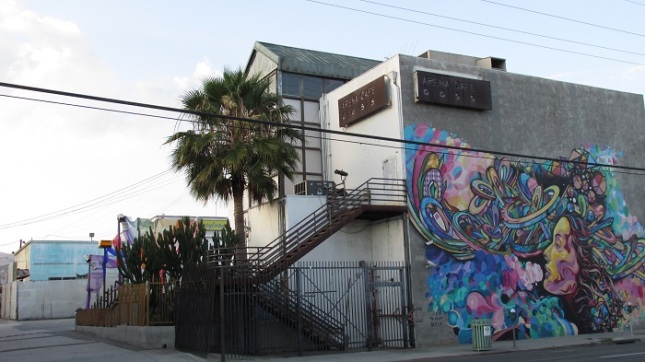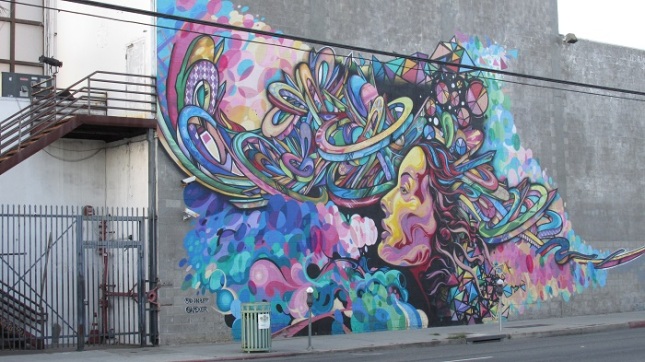
Not too long ago I took a trip down to Westlkake/MacArthur Park. It’s a popular gathering place on weekends. Thousands of people show up there to play games, listen to music, attend worship services, or maybe just lie on the grass and stare up at the sky.
The park was created by civic leaders back at the end of the nineteenth century. It’s bounded by Sixth, Alvarado, Seventh and Park View. Originally christened Westlake Park, the name was later changed to MacArthur Park, after the five star general who played a prominent role during WWII. Some years ago there was an intense debate over which name was more appropriate. When you ride the Red Line to Seventh and Alvarado, the automated PA announces Westlake/MacArthur Park.
When I first came up out of the subway, the first thing I saw was the crush of street vendors lining the sidewalk. There were dozens of people selling everything from jewelry to DVDs.

Street vendors on Alvarado.
On the other side of Alvarado there were also people selling juices and ices from carts.

More vendors on the other side of Alvarado.
The City is currently considering new rules to regulate vending on sidewalks and in parks, and the debate is pretty contentious. Merchants in brick and mortar stores are angry because they’re competing with people who can operate with no overhead, and so offer lower prices. There are definite health concerns about vendors selling food without a license. But these people are just trying to make a buck like everyone else. This is their livelihood. I’m sure the debate will continue for years to come, and I doubt anyone will find a solution that makes everybody happy.
There was a woman at the corner of Seventh and Alvarado bellowing through a megaphone about how people should give their lives to Christ.

A woman evangelizing at Seventh and Alvarado.
I’ve gotta say, this really drives me crazy. I know she feels like she needs to preach the Gospel, but there are plenty of Christians who do the same thing without resorting to amplified rants on a street corner.
At the corner of Seventh and Alvarado you have Langer’s, a deli that’s been around forever. I haven’t been there for years. Some day I’ll have to go back and check it out.

Langer’s
Up at Wilshire and Alvarado stands the Westlake Theatre, which opened in 1926. It stopped showing movies a long time ago. For a while it was a swap meet, but it looks like it’s completely closed now.

Westlake Theatre
The park bisected by Wilshire, which runs right down the middle of it, but there are tunnels running underneath that allow people to pass from one side to the other.

A view of Wilshire facing Park View

A view of Wilshire facing Alvarado.
Now let’s head into the park.

Entrance to the park at Seventh and Alvarado.
But first, make sure you know the rules.

Sign posted inside the park.
As you can see, a lot of people are just looking for a shady spot where they can hang out and relax.

Trees provide plenty of shade.
But not everybody is kicking back. Soccer is big here, and on weekends teams of kids take turns honing their skill on the field. Families line up around the perimeter, watching, cheering, coaching.

Kids playing soccer.

Families standing on the sidelines.

Soccer stars of tomorrow.
This looks like a pretty innocent shot of a food truck parked on Wilshire. But notice the graffiti on the concrete. “MS” stands for Mara Salvatrucha, a brutal gang that has a presence in the neighborhood. Fortunately, gang violence has been declining all over LA for several years. And the crowds of people enjoying the park didn’t seem concerned for their safety. The vibe was very relaxed.

Food truck parked on Wilshire.
The Levitt Pavilion offers a wide range of entertainment, and it’s free.

Levitt Pavilion

Performers getting ready for a show.
This is one of the tunnels that goes under Wilshire, linking the two sides of the park.

Tunnel running beneath Wilshire.

Mural running the length of the tunnel.
The lake is a draw for birds of all kinds. Please don’t ask me to name the different varieties. I know some of them are ducks. Other than that, I have no idea.

Birds at the edge of the lake.
If you want to learn more about the park’s history, the link below will lead you to an article on the KCET web site that talks about its origins. Aside from the information, it includes some amazing images of the area through the years.
How a Neighborhood Dump Became a Civic Treaure
And this article on Wikipedia offers more detail on some interesting chapters in the life of the park.
Westlake/MacArthur Park on Wikipedia





























